
You could be wrong if you think that every work is a project. While all the projects are work, not all work is a project. So, if you want to manage projects, you need to get the basics right. And that includes understanding what a project is and what it includes.
We have defined what is a project and explained its characteristics to help you have a strong project management base. Not only that, we have also explained what project management is and how you can get better at it. So, let’s begin:
What is A Project?
A project is a set of tasks to be finished within a certain time to achieve a goal. Projects often vary in complexity, from simple tasks like organizing an event to large-scale initiatives like building infrastructure or developing software.
Key elements or characteristics of a project include defining objectives, allocating resources, establishing a timeline, and monitoring progress. Effective project management involves planning, executing, and controlling these elements to ensure successful completion while adhering to budget, time, and quality constraints, ultimately delivering the intended result or product.
What are the Characteristics of A Project?
Now that you know the definition of a project, let’s move on to see the characteristics of a project that sets it apart from routine activities in the business world.
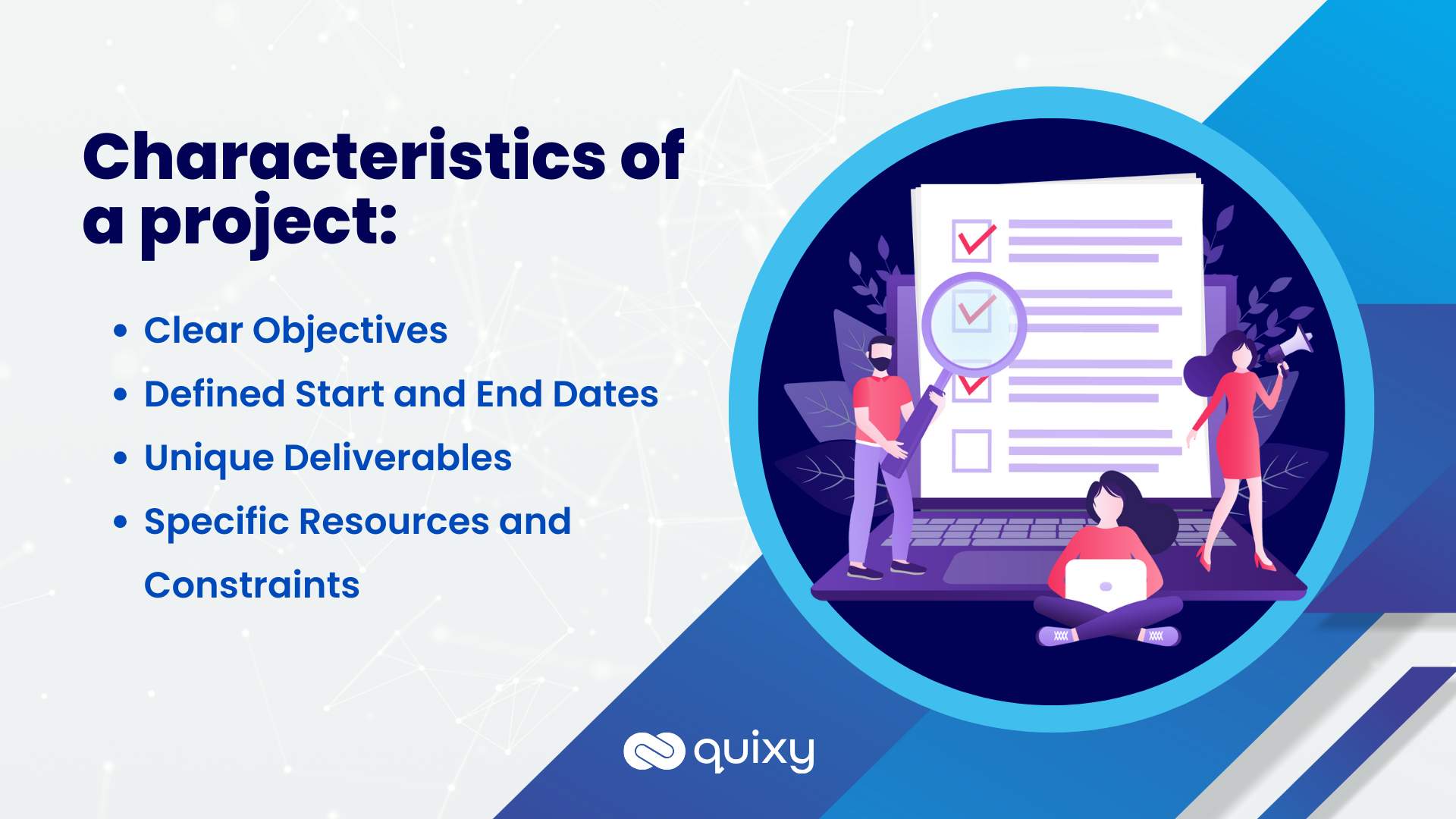
1. Clear Objectives
Every project must commence with a crystal-clear objective. This objective serves as the project’s compass, ensuring that all team members are aligned with what needs to be accomplished. Without well-defined goals, a project can easily veer off course, leading to confusion and inefficiency.
2. Defined start and end dates
Projects have a finite lifespan, unlike ongoing operational tasks. They have a specific start date, which marks the initiation of project activities, and a predetermined end date when the project is expected to be completed. This time-bound nature allows for effective planning, resource allocation, and progress tracking.
3. Unique deliverables
Projects are all about creating something unique. Whether it’s a new product, a specialized service, or a novel process improvement, projects yield distinctive and one-of-a-kind outcomes. These deliverables are the tangible or intangible results that justify the project’s existence and provide value to the organization.
4. Specific resources and constraints
Each project operates within a set of predefined constraints. These can include budget limitations, availability of resources (like manpower and equipment), scope boundaries, and quality standards. Skillful project management involves optimizing these resources while navigating these constraints to achieve the project’s objectives efficiently and effectively.
What are the Types of Projects?

Projects can be divided into 4 main categories:
1. Traditional projects
Traditional projects follow a linear, well-structured approach to project management. They often involve a sequential series of phases, each completed before moving on to the next. This approach is rooted in meticulous planning and documentation upfront, and any changes to the project scope are typically managed through formal change control procedures. Traditional projects are commonly found in industries with strict regulatory requirements, such as construction and aerospace.
2. Agile projects
Agile projects represent a more flexible and adaptive approach to project management. Agile methodologies, like Scrum or Kanban, promote collaboration, continuous improvement, and customer feedback. Projects are broken down into smaller and better manageable iterations, allowing for incremental development and regular adjustments based on evolving requirements. Agile approaches are widely embraced in the software development industry.
Also Read: Hybrid Project Management: Combining Structure and Agility for Better Results
3. Remote projects
Remote projects involve teams working from different locations, often facilitated by digital communication tools and collaboration platforms. This project type has gained prominence in recent years, driven by advancements in technology and the global adoption of remote work practices. The COVID-19 pandemic further accelerated the acceptance of remote projects.
4. Agency projects
Agency projects pertain to initiatives managed by creative or marketing agencies on behalf of clients. These projects encompass various creative and marketing services, including advertising campaigns, branding, web development, and content creation. Success in agency projects hinges on understanding the client’s objectives and target audience.
Also Read: The Hidden Cost of Inefficient Project Management(and How to Fix It Fast)
Industry-specific project types
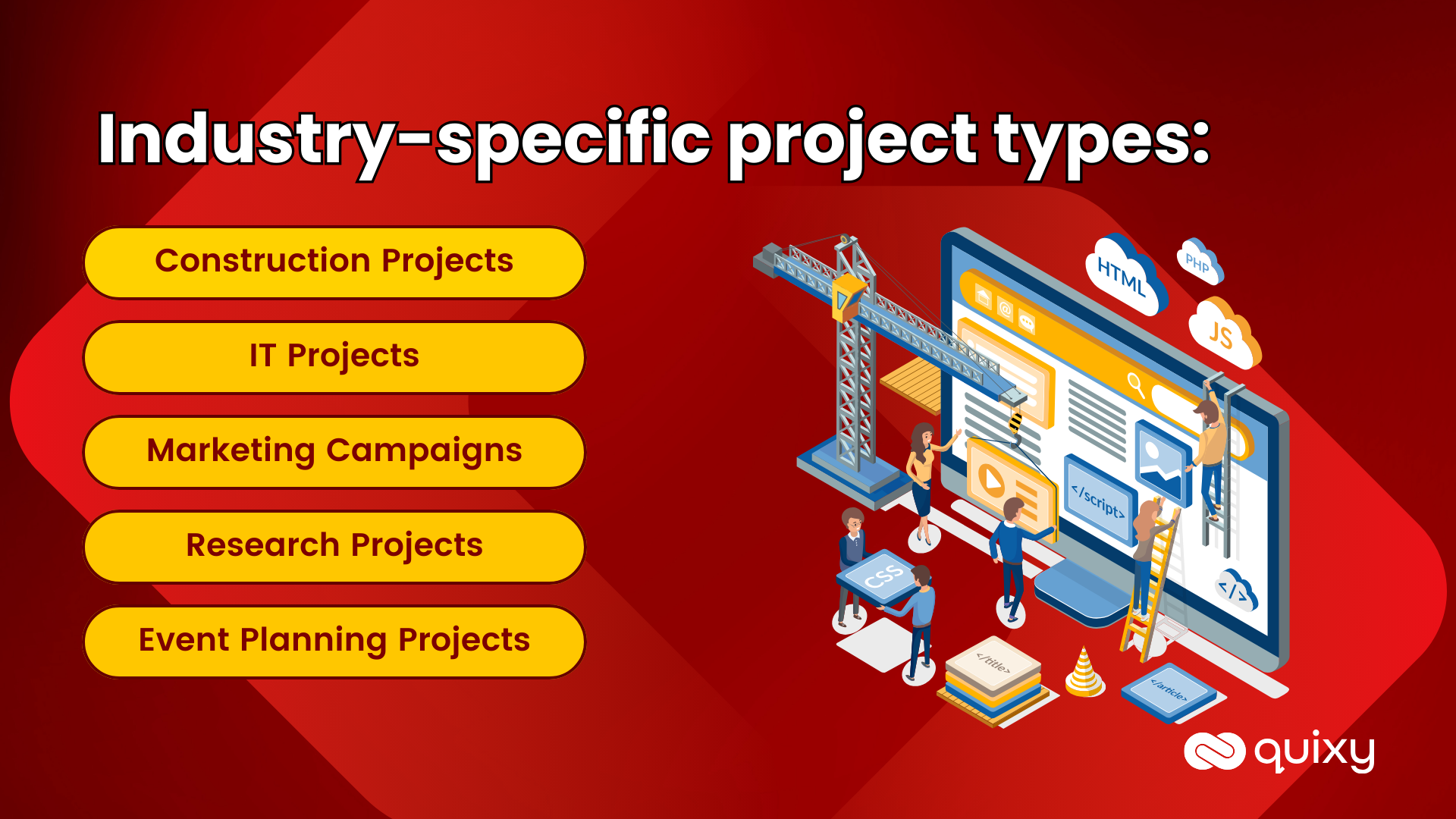
While there are four main categories of projects, projects can be classified according to industry. Some of these are:
1. Construction projects
Construction projects involve the planning, design, and execution of physical structures and facilities. They shape our physical environment and contribute significantly to economic development. For instance, building a state-of-the-art hospital requires meticulous architectural design, site preparation, construction phases, and adherence to safety regulations.
2. IT projects
IT (Information Technology) projects drive digital innovation and transformation. They encompass the development, implementation, or enhancement of software and technology solutions. A prime example is the creation of a cutting-edge mobile banking app. This IT project involves software design, coding, rigorous testing, and quality assurance measures.
3. Marketing campaigns
Marketing campaigns are strategic initiatives aimed at promoting products, services, or brands. They leverage creative content and various marketing channels to reach target audiences. Consider a nationwide advertising campaign for a new soft drink. This marketing project involves market research, creative content creation, media planning, and performance tracking.
4. Research projects
Research projects are the backbone of scientific inquiry and knowledge advancement. They involve systematic investigation, data collection, and analysis to gain insights or solve problems. A medical research project aimed at finding a cure for a specific disease is a prime example. It includes experimental design, data collection, analysis, and publication of findings, contributing to medical progress.
5. Event planning projects
Event planning projects require meticulous coordination and execution of gatherings or conferences. They bring people together for various purposes, from business networking to knowledge sharing. Organizing a corporate conference is a complex event planning project. It entails venue selection, speaker invitations, logistics management, and security measures.
Types of Projects By Project Management Methodology
Here are some types of projects categorized by project management methodologies:
Waterfall Methodology:
- Construction projects
- Manufacturing projects
- Infrastructure development
- Engineering projects
- Any project with well-defined, sequential phases and rigid requirements
Agile Methodology:
- Software development projects
- Product development projects
- Projects requiring flexibility and iterative approaches
- Projects with evolving or unclear requirements
- Dynamic or innovative projects
Lean Methodology:
- Process improvement projects
- Streamlining operations projects
- Projects focused on reducing waste and increasing efficiency
- Continuous improvement initiatives
Six Sigma Methodology:
- Quality improvement projects
- Projects aimed at reducing defects or errors in processes
- Statistical analysis-driven projects
- Projects focused on achieving process excellence
PRINCE2 (Projects IN Controlled Environments) Methodology:
- Government projects
- Large-scale projects with strict governance and documentation requirements
- Projects requiring detailed planning and risk management
Hybrid or Customized Methodologies:
- Projects that combine aspects of different methodologies
- Tailored approaches to meet specific project needs
- Unique projects that don’t fit squarely into a single methodology
Note: Projects can often fit into multiple methodologies or use a combination of approaches based on their nature, requirements, and industry standards.
Also Read: Project Management Hacks 101
What are the Phases of A Project?
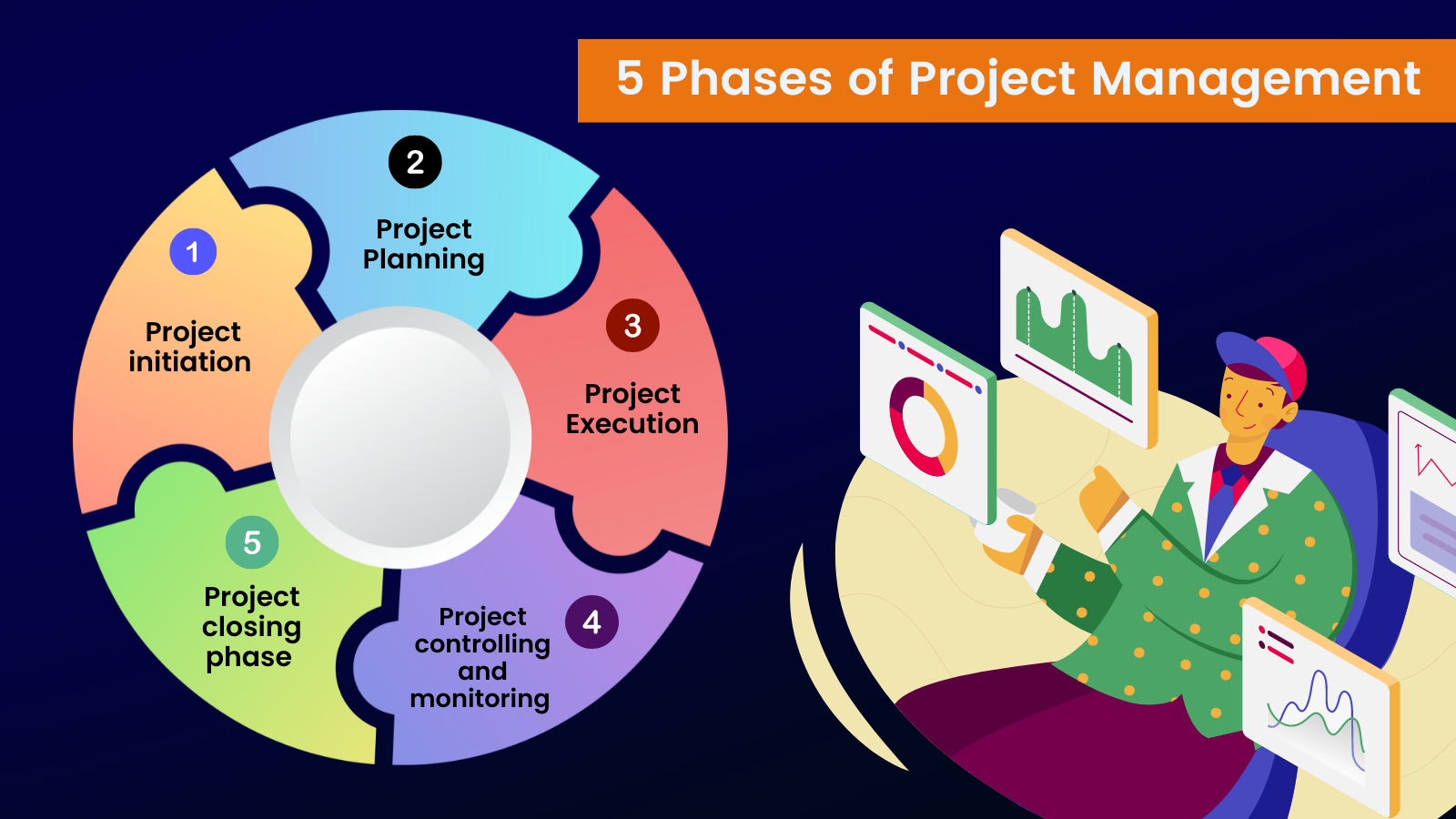
Creating a project is one thing, and successfully completing it is another. It is essential to ensure that projects are achieved on time, within budget, and to the desired quality. This is where project management comes in, which involves the following steps or phases.
1. Initiation phase
The project initiation phase is the first stage in project management. It involves defining the project’s purpose, scope, objectives, and stakeholders. Key activities include:
- Project charter: Creating a formal document that authorizes the project, outlining its objectives, scope, constraints, and high-level schedule.
- Stakeholder identification: Identifying and categorizing all individuals or groups with an interest in the project, determining their influence and expectations.
- Feasibility study: Assessing the project’s feasibility in terms of technical, financial, operational, and organizational aspects.
2. Planning phase
The project planning phase is a critical stage where detailed plans and strategies are developed to guide the project’s execution. Key activities include:
- Scope definition: Clearly define the project’s objectives, deliverables, and boundaries to clearly understand what the project will achieve and what it won’t.
- Work breakdown structure (WBS): Breaking down the project into smaller, manageable tasks or work packages, creating a hierarchical structure to organize and plan the work.
- Schedule development: Creating a project schedule that outlines when each task or work package will be completed, considering task dependencies and resource availability to establish a timeline for the project’s activities.
3. Execution phase
Execution is where the actual work of the project takes place. It involves implementing the project plan, managing resources, and monitoring progress. Key activities during this phase include:
- Task execution: Team members carry out the tasks outlined in the project plan. This involves coordinating activities, managing resources, and ensuring that work is completed according to quality standards.
- Resource management: Efficiently allocating and managing resources, including human resources, equipment, and materials, to ensure that tasks are completed on time & within budget.
- Quality control: Implementing the quality standards and processes defined in the project plan to ensure that project deliverables meet the required quality criteria.
4. Monitoring and control phase
This phase is all about overseeing the project’s progress, ensuring that it stays on track, and making necessary adjustments to achieve project objectives. It involves continuous monitoring, measurement, and control of project performance. Key activities include:
- Performance measurement: Collecting data and metrics to assess whether the project is meeting its objectives, staying within budget, and adhering to the schedule.
- Issue identification and resolution: Identifying deviations or issues arising during project execution and implementing corrective actions to address them promptly.
- Scope change management: Managing changes to the project scope by evaluating their impact on the project’s objectives, timeline, and budget and obtaining approval for scope changes when necessary.
5. Closure phase
Project closure marks the formal conclusion of a project. It involves a series of activities to ensure all project objectives are met, resources are appropriately released, and lessons learned are documented. Key activities include:
- Project evaluation: Conduct a comprehensive evaluation of the project’s performance, comparing actual outcomes to the planned objectives and identifying any variances or deviations.
- Lessons learned: Documenting lessons learned from the project, including successes, challenges, and areas for improvement. This knowledge can inform future projects.
- Formal closure: Preparing and disseminating a formal closure report or document that summarizes the project’s results, including achievements, challenges, and recommendations, and obtaining formal project closure approval from stakeholders or sponsors.
Also Read: Top 7 Project Management Tools to Look Out for
How Do You Manage a Project Effectively?
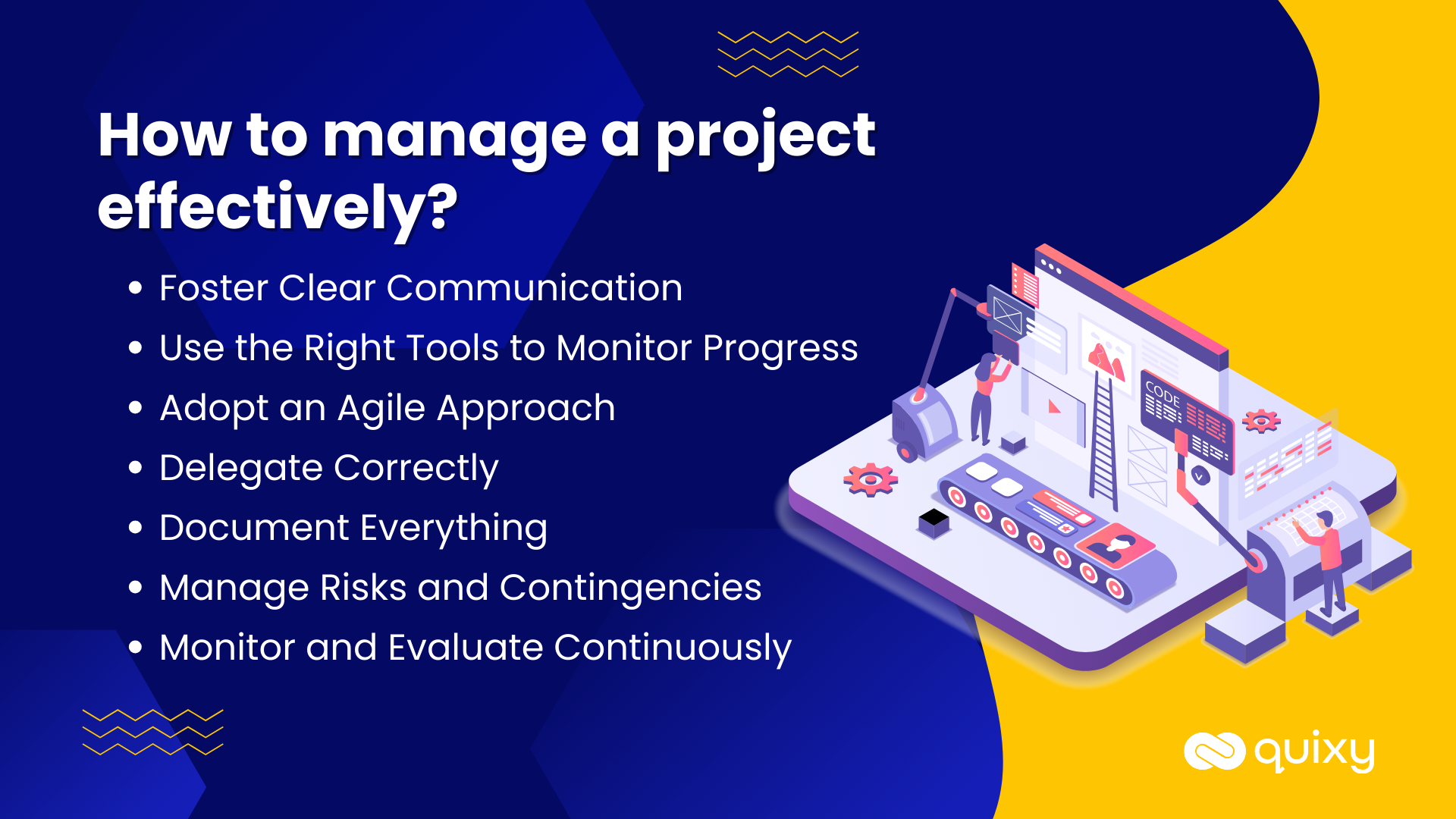
Managing a project effectively demands a combination of skills, strategies, and attention to detail. Here are some tips on how you can manage a project effectively:
1. Foster clear communication
Effective project management hinges on clear and open communication. Ensure all members understand their roles, responsibilities, and project objectives. Establish regular communication channels to facilitate information exchange, including meetings, emails, and collaboration tools. Encourage team members to voice concerns, ask questions, and provide updates promptly. Transparency in communication builds trust and minimizes misunderstandings.
2. Use the right tools to monitor progress
Choosing the appropriate project management tools is crucial. These tools help you track progress, allocate resources, and manage timelines efficiently. Additionally, consider using Gantt charts to visualize project timelines and dependencies. Robust project management software provides real-time updates and dashboards for a comprehensive overview of project status.
3. Adopt an agile approach
Agile project management methodologies, such as Scrum or Kanban, promote flexibility and adaptability in response to changing project requirements. Break down projects into smaller, manageable tasks or sprints. Hold regular short meetings, known as “stand-ups” or “sprint reviews,” to assess progress, adapt to evolving needs, and prioritize work. Agile approaches empower teams to deliver incremental value and ensure alignment with customer expectations.
Also Read: Project Management Simplified for Non-Project Managers
4. Delegate correctly
Effective delegation is crucial for efficient project management. Assign tasks & responsibilities to team members based on their skills, expertise, and availability. Clearly define each team member’s scope of work, expectations, and deadlines. Encourage autonomy and trust in team members to take ownership of their assigned tasks. Regularly check in to provide guidance and support while allowing them the freedom to execute their responsibilities effectively.
5. Document everything
Comprehensive documentation is the backbone of successful project management. Create detailed project plans, including objectives, milestones, timelines, and resource allocation. Keep a record of meetings, decisions, and action items. Document any changes or deviations from the original project plan. Effective documentation helps maintain project history, track progress, and address potential issues or disputes.
6. Manage risks and contingencies
Identify potential risks and uncertainties that may impact the project’s success. Develop a risk management plan outlining strategies for risk mitigation, contingency plans, and risk response procedures. Regularly review & update the risk register to address emerging threats promptly. Being proactive in risk management ensures that unexpected challenges are handled efficiently without derailing the project.
7. Monitor and evaluate continuously
Continuous monitoring and evaluation are essential to ensure that the project aligns with the objective. Use key performance indicators (KPIs) and metrics to assess progress and measure success against predefined goals. Regularly review project status with stakeholders to obtain feedback and make necessary adjustments. Post-project evaluations allow for lessons learned, enabling improvements in future projects.
Also Read: Mastering Project Management: Phases and Methodologies
Project Lifecycle
- Initiation: Define goals, feasibility, and stakeholders. Create a project charter.
- Planning: Develop schedules, budgets, and risk plans. Tools like Work Breakdown Structures (WBS) are used.
- Execution: Teams execute tasks, resources are allocated, and deliverables are produced.
- Monitoring & Controlling: Track progress via KPIs, adjust plans, and manage changes.
- Closing: Finalize deliverables, conduct retrospectives, and release resources.

How to Make a Project a Success
- Clear Objectives: SMART goals (Specific, Measurable, Achievable, Relevant, Time-bound).
- Communication: Regular updates via meetings or tools like Slack.
- Risk Planning: Proactive identification (e.g., SWOT analysis).
- Stakeholder Engagement: Ensure alignment through constant feedback.
- Tools & Methodologies: Use Agile for flexibility or Waterfall for structured phases.
When is a Project considered a success?
A project is typically considered a success when it meets or exceeds predefined objectives within the constraints of time, budget, scope, quality, and stakeholder expectations. Such as:
- Meeting or exceeding predefined objectives
- Adherence to time, budget, scope, quality, and stakeholder expectations
- Achieving intended outcomes or benefits outlined in project goals
- Effective communication throughout the project lifecycle
- Stakeholder satisfaction
- Timely completion of deliverables
- Staying within budgetary constraints
- Delivering high-quality results
- Meeting specified requirements
- Adding value to the organization or stakeholders
- Contribution to overall business goals
What are the benefits of project management?
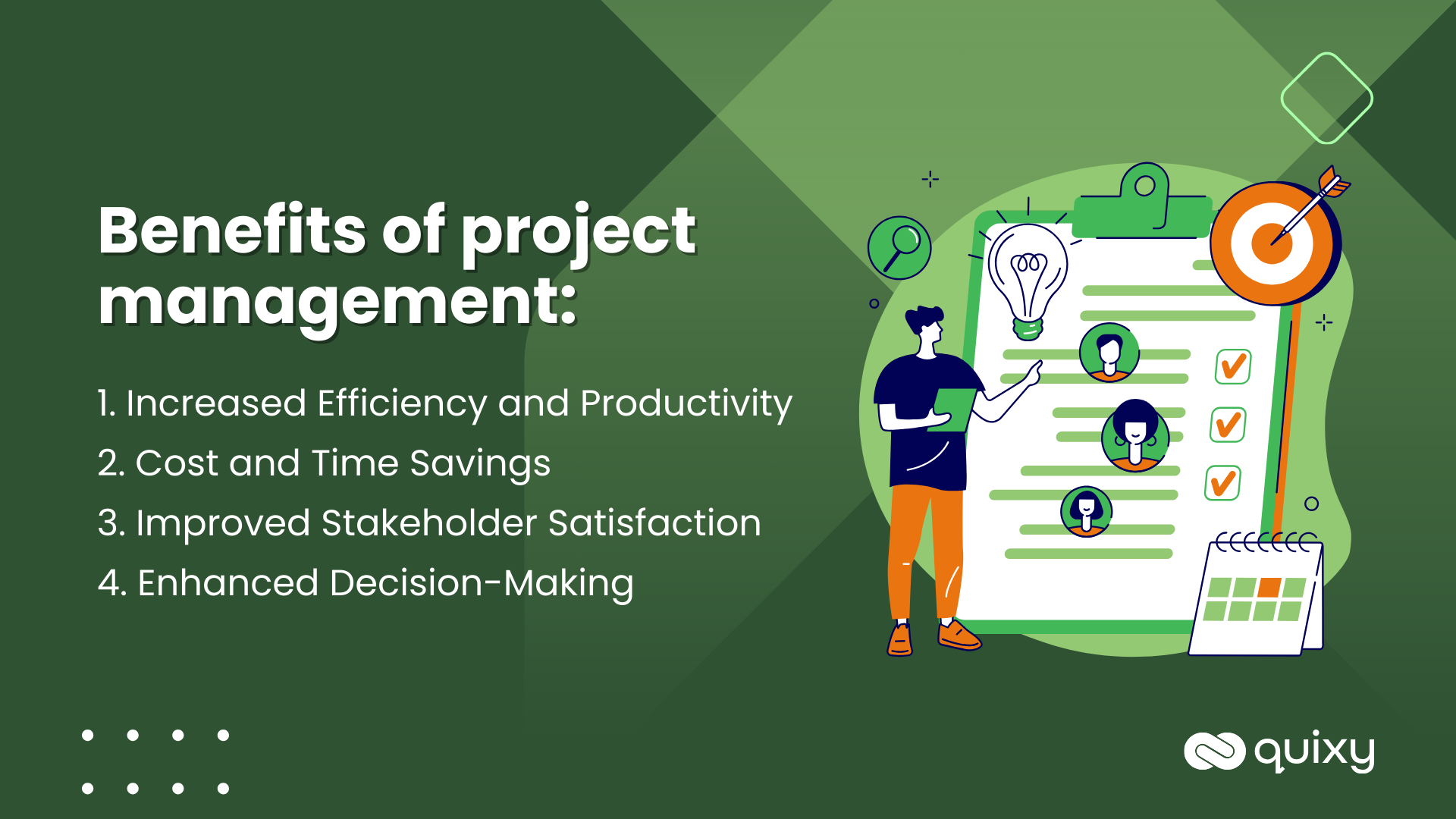
Creating and managing a project plan requires a lot of work and effort. And these efforts get rewarded in the form of benefits of project management. Let us have a look at some of those advantages:
1. Increased efficiency and productivity
Effective project management streamlines processes and optimizes resource allocation. By defining clear objectives, roles, and responsibilities, teams can work more efficiently. Tasks are prioritized, and unnecessary bottlenecks are eliminated. This results in improved productivity as team members clearly understand their roles, project goals, and timelines. Teams can focus their efforts on high-impact activities, reducing wastage of time and resources.
2. Cost and time savings
One of the most significant advantages of effective project management is cost and time savings. Through careful planning and resource allocation, projects are more likely to stay within budget and meet deadlines. Efficient project management helps identify potential risks & issues early in the project lifecycle with timely interventions. Moreover, it reduces the need for costly rework and delays, ultimately saving both time and money.
3. Improved stakeholder satisfaction
Effective project management strongly emphasizes stakeholder engagement and communication. By keeping stakeholders informed & involved throughout the project, their expectations are managed effectively. When stakeholders clearly understand the project’s progress and any potential changes, they are more likely to be satisfied with the project’s end results. This leads to stronger relationships, increased trust, and positive feedback from stakeholders.
4. Enhanced decision-making
Project managers rely on data-driven decision-making processes to navigate projects successfully. They gather and analyze information, monitor key performance indicators (KPIs), and use these insights to make informed decisions. This data-centric approach allows for quick adjustments to project strategies when necessary, resulting in better outcomes. Effective project management also encourages proactive problem-solving and risk mitigation, contributing to more informed and sound decisions.
What Does a Project Manager Do?
A Project Manager (PM) is the linchpin of any project, responsible for guiding it from conception to completion while balancing scope, time, cost, and quality. Here’s a detailed breakdown of their multifaceted role:
1. Planning: Defining the Roadmap
- Task Breakdown: Translates project goals into actionable tasks using tools like Work Breakdown Structures (WBS) to ensure clarity.
- Timeline Development: Creates schedules using Gantt charts or Agile boards (e.g., Scrum sprints) to map deadlines and dependencies.
- Resource Allocation: Assigns team members, budgets, and tools to tasks, ensuring optimal utilization.
Example: A PM planning a software launch might use a Gantt chart to align coding, testing, and marketing phases.
2. Team Leadership: Building and Guiding the Crew
- Motivation: Fosters a collaborative environment through regular check-ins, recognition, and clear communication.
- Conflict Resolution: Mediates disagreements by addressing root causes (e.g., misaligned priorities) and reinforcing shared goals.
- Methodologies: Implements frameworks like Agile (for flexibility) or Waterfall (for structured phases) based on project needs.
Example: A PM running a remote team might use daily standups via Zoom to maintain engagement.
3. Budget Management: Controlling Costs
- Tracking Expenses: Monitors spending against forecasts using tools like Excel or ProjectManager software.
- Cost Optimization: Identifies inefficiencies (e.g., redundant tasks) and reallocates resources to stay on budget.
- Forecasting: Predicts future expenses using historical data to avoid overruns.
Example: A PM managing a construction project might renegotiate vendor contracts to reduce material costs.
4. Risk Mitigation: Preparing for the Unexpected
- Risk Identification: Conducts SWOT analyses or brainstorming sessions to pinpoint potential threats (e.g., supply chain delays).
- Contingency Planning: Develops backup plans, such as alternative suppliers or extended timelines.
- Monitoring: Uses risk registers to track and update mitigation strategies as the project evolves.
Example: A PM overseeing an event might plan for weather disruptions by securing indoor backup venues.
5. Reporting: Keeping Stakeholders Informed
- Status Updates: Delivers progress reports highlighting milestones achieved, budget status, and risks.
- Tailored Communication: Adjusts reporting depth for different stakeholders (e.g., high-level summaries for executives, detailed updates for clients).
- Tools: Uses dashboards in tools like ProjectManager to visualize data in real time.
Example: A PM might share a dashboard with investors showing a 20% cost savings midway through a project.
Skills Required for Success
- Leadership: Inspires teams through vision and decisiveness.
- Negotiation: Balances stakeholder expectations (e.g., scope changes vs. deadlines).
- Technical Proficiency: Mastery of tools like MS Project (for scheduling), Jira (for Agile teams), or Power BI (for analytics).
- Adaptability: Pivots strategies in response to unforeseen challenges.
How Project Managers Simplifies PM
Project Managers use cloud-based platform designed to streamline every aspect of project management. Here’s how its features directly address a PM’s responsibilities:
1. Gantt Charts: Mastering Timelines
- Dynamic Scheduling: Drag-and-drop functionality allows PMs to adjust timelines instantly.
- Dependency Tracking: Visualizes task relationships (e.g., “Design must finish before development starts”).
- Critical Path Analysis: Identifies tasks that could delay the project if overdue.
Impact: Simplifies planning and keeps teams aligned on priorities.
2. Real-Time Dashboards: Instant Insights
- Customizable Metrics: Tracks KPIs like budget burn rate, task completion %, and workload distribution.
- Live Data: Updates automatically as team members log progress, eliminating manual data entry.
Impact: Enables proactive decision-making, such as reallocating resources to lagging tasks.
3. Collaboration Hub: Unifying Teams
- Centralized Communication: Threaded comments and @mentions keep discussions task-focused.
- File Sharing: Stores documents (e.g., specs, contracts) in a single location with version control.
Impact: Reduces email clutter and ensures everyone accesses the latest information.
4. Automation: Eliminating Busywork
- Report Generation: Auto-generates status reports, budget summaries, or risk analyses.
- Alerts: Notifies PMs about overdue tasks, budget thresholds, or milestone completions.
Impact: Frees up time for strategic tasks like stakeholder engagement.
5. Integration: Connecting Tools
- Seamless Sync: Links with Slack (for communication), Excel (for data import/export), and Google Drive (for file storage).
- API Access: Custom integrations with CRM, ERP, or DevOps tools.
Impact: Consolidates workflows, reducing app-switching fatigue.
Also Read: Revamp Project Management with No-Code
Project Management and No-Code Low-Code Tools
Are you unsure about managing projects effectively? Picture this: the fusion of meticulous project management strategies with the revolutionary capabilities of no-code/low-code tools. It’s a symphony orchestrating a new era of innovation and efficiency.
Project management traditionally involved intricate planning, resource allocation, and meticulous execution. However, this landscape is rapidly evolving. No-code/low-code platforms enable project managers to transform ideas into reality swiftly. These tools empower teams to develop applications and automate processes with visual interfaces, reducing the dependence on traditional coding methods.
Imagine the agility of steering a digital transformation initiative where project managers collaborate seamlessly with IT and business stakeholders. No-code/low-code platforms bridge this gap, fostering a collaborative environment where ideas morph into tangible solutions rapidly. Teams iterate, prototype, and deploy applications swiftly, aligning with evolving business needs in real-time.
Also, these tools amplify the democratization of software development. Non-technical personnel now actively contribute to innovation. No longer confined by coding limitations, diverse teams ideate and innovate, fostering a culture of creativity and agility. This democratization sparks a new wave of innovation, driving companies toward digital maturity at an unprecedented pace.
Aligning project management methodologies and no-code/low-code tools also unveils significant cost and time savings. Businesses witness accelerated ROIs and increased productivity by streamlining processes, reducing development cycles, and enhancing flexibility. It’s not just about building applications; it’s about shaping a transformative mindset within organizations.
However, amidst this wave of innovation, challenges persist. Integrating these tools seamlessly into existing workflows, ensuring adequate security measures, and promoting a learning culture to embrace these technologies are critical considerations.
Emerging Trends in Project Management
Project management is an ever-evolving field, continually influenced by technological advancements, changing workforce dynamics, and evolving business landscapes. Here are some emerging trends shaping the future of project management:
Project Glossary Essentials
- Scope: The boundaries or extent of what a project will deliver, including tasks, resources, features, and deliverables.
- Deliverables: Tangible or intangible products, results, or outcomes produced as part of the project.
- Stakeholders: Individuals or groups impacted by the project, including sponsors, team members, customers, and end-users.
- Timeline/Schedule: The planned sequence of activities or tasks and their allocated timeframes for completion.
- Budget: The allocated funds or financial resources assigned to the project to cover expenses and costs.
- Risk: Potential events or circumstances that can impact the project’s objectives, schedule, budget, or quality.
- Quality: The degree to which the project’s deliverables meet specified requirements and satisfy stakeholders.
- Resources: People, materials, equipment, or assets required to complete project tasks and achieve objectives.
- Change Management: Processes and strategies to handle modifications or alterations to project scope, timeline, or requirements.
- Milestones: Significant points or achievements in the project timeline used to track progress.
- Critical Path: The sequence of tasks or activities that determine the minimum time needed to complete the project.
- Communication Plan: A structured strategy outlining how project information will be shared among stakeholders.
- Agile: An iterative project management approach that focuses on flexibility, collaboration, and adaptability to change.
- Gantt Chart: A visual representation showing project tasks, timelines, dependencies, and progress.
- Project Closure: The final phase where the project is formally completed, including documentation, evaluation, and handover of deliverables.
Understanding these terms helps in effective project planning, execution, and communication among team members and stakeholders.
Simplify Projects with Quixy
Even the most well-planned projects can encounter complexities. To navigate these challenges effectively, it’s essential to select a project management software that offers effortless management and rapid app development. Look for a platform that boasts exotic features designed to streamline your workflows, enhance collaboration, and provide real-time insights.
Quixy is an excellent choice for project management. As a powerful no-code platform, Quixy empowers you to create custom applications without the need for extensive coding. Its intuitive interface and pre-built templates make it easy to develop applications quickly, even for those without technical expertise. With Quixy, you can streamline your workflows, enhance collaboration among team members, and gain valuable insights into project progress.
Conclusion
Effective project management is all about clear communication, smart planning, staying flexible, and using data to make the right calls. When you do it right, you’ll see more efficiency, save time and money, keep everyone happy, and make better decisions. No matter, if you’re building something, working in IT, doing marketing, research, or planning events, effective project management will help you achieve your goals.
The synergy between project management methodologies and no-code/low-code tools is rewriting the narrative of digital transformation. It’s more than just technology; it’s a cultural shift toward agility, innovation, and democratization. Embrace this dynamic fusion, and embark on a transformative journey into the future of digital excellence.
Frequently Asked Questions(FAQs)
Q. Can no-code/low-code tools integrate with existing systems?
Yes, most no-code/low-code platforms offer robust integration capabilities, allowing seamless connectivity with existing systems. These tools often provide APIs, connectors, and plug-ins that facilitate smooth integration, enabling users to link databases, applications, and services, ensuring interoperability and enhancing the overall functionality of the ecosystem.
Q. How do LCNC tools simplify project development processes?
No-code/low-code tools simplify project development by eliminating the need for extensive coding knowledge. With intuitive visual interfaces, drag-and-drop functionalities, and pre-built templates, these tools enable users to design, develop, and deploy applications quickly. By streamlining workflows and automating repetitive tasks, LCNC tools expedite project timelines and empower teams to focus on innovation and problem-solving.
Q. What security measures do no-code/low-code platforms employ?
No-code/low-code platforms prioritize security by implementing various measures. These include data encryption, role-based access controls, secure authentication methods, regular security audits, and compliance with industry standards (such as GDPR or HIPAA). Additionally, some platforms offer robust monitoring and alert systems to safeguard against potential vulnerabilities, ensuring data integrity and user privacy.
Q. How do no-code/low-code platforms benefit project managers?
No-code/low-code platforms empower project managers by offering tools that streamline project execution. These platforms enable quicker prototyping, iteration, and deployment of applications without extensive coding expertise. Project managers gain agility in adapting to changing project requirements, improved collaboration among team members, and enhanced efficiency in delivering projects within deadlines.
Q. Can I use no-code/low-code tools without coding expertise?
Absolutely! No-code/low-code tools are designed to be user-friendly, allowing individuals without extensive coding knowledge to create applications and automate processes. With intuitive interfaces, simple drag-and-drop functionalities, and comprehensive tutorials, these platforms democratize software development, enabling users from diverse backgrounds to contribute effectively to project development and management.
Login
Please login to comment
0 Comments
Oldest















